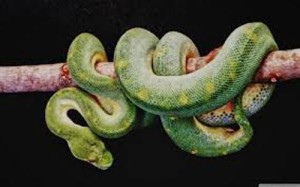

The name recently suggested for this morphological variant, is Corallus batesii.

Some herpetologists have considered whether they should be classified as a new species based on locality. As opposed to popular belief, yellow juveniles (as in the green tree python) do not occur in the emerald tree boa. This also occurs in green tree python ( Morelia viridis), a python species in which hatchlings and juveniles may also be canary yellow or brick-red. Juveniles vary in color between various shades of light and dark orange or brick-red before ontogenetic coloration sets in and the animals turn emerald green (after 9–12 months of age). The bright coloration and markings are very distinctive among South American snakes. The color pattern typically consists of an emerald green ground color with a white irregular interrupted zigzag stripe or so-called 'lightning bolts' down the back and a yellow belly. They have highly developed front teeth that are likely proportionately larger than those of any other non-venomous snake. Adults grow to about 6 feet (1.8 m) in length. The reticulated python reaching and the green anaconda have both been found in South Florida.At the Philadelphia Zoo in Philadelphia, PennsylvaniaĪnother name for Emerald tree boas is "Corallus caninus". Breeding populations of Burmese python and boa constrictor have been confirmed in South Florida, and there is evidence that the northern African python is breeding in the wild as well. Private ownership of boa constrictors and most other snake species is prohibited in Puerto Rico because of fears of non-native snakes becoming established. "We’ve learned from dealing with other invasive snakes that understanding the source of these populations and preventing spread as soon as possible is important to protect ecosystems," said USGS scientist and study co-author Bob Reed. Because the snakes are secretive and difficult to spot, the researchers suspect the population size is large. Such movement could potentially increase the rate of spread of this invasive snake. Two snakes found some distance from the expanding Mayagüez population share genetic markers with that population, suggesting that people might be intentionally or unintentionally moving the snakes around the island. "Experience has shown that island ecosystems are particularly vulnerable to snake invasions, and unfortunately Puerto Rico has no natural predators that can keep the numbers of these prolific, snakes in check," said USGS Director Marcia McNutt. First-hand accounts from local officials suggest that newborn boas were released in Mayagüez in the early 1990s. Genetic studies conducted by the researchers indicate that individual boas on the island are highly related and that the population probably originated with a small number of snakes that had been pets. The established boa constrictor population likely originated from the pet trade. The bulk of their diet consists of rodents, but larger lizards and mammals as big as ocelots are also reported to have been consumed. Prey includes a wide variety of mammals and birds. It is commonly found in or along rivers and streams. However, it prefers to live in rainforest due to the humidity and temperature, natural cover from predators and vast amount of potential prey. In the last year alone, more than 150 boas have been found in the wild on the island.īoa constrictor flourishes in a wide variety of environmental conditions, from tropical rainforests to arid semi-desert country. The new population appears to be spreading from its likely point of origin in the western part of the island around the city of Mayagüez. While boa constrictors and two species of pythons have established invasive populations in Florida, this research is the first to document a large constrictor species established in the United States or its territories outside of Florida. Non-native boa constrictors, which can exceed 10 feet and 75 pounds, have established a breeding population in Puerto Rico, one that appears to be spreading, according to research published in the journal Biological Invasions. It is a member of the family Boidae found in North, Central, and South America, as well as some islands in the Caribbean. Boa constrictor is a species of large, heavy-bodied snake.


 0 kommentar(er)
0 kommentar(er)
